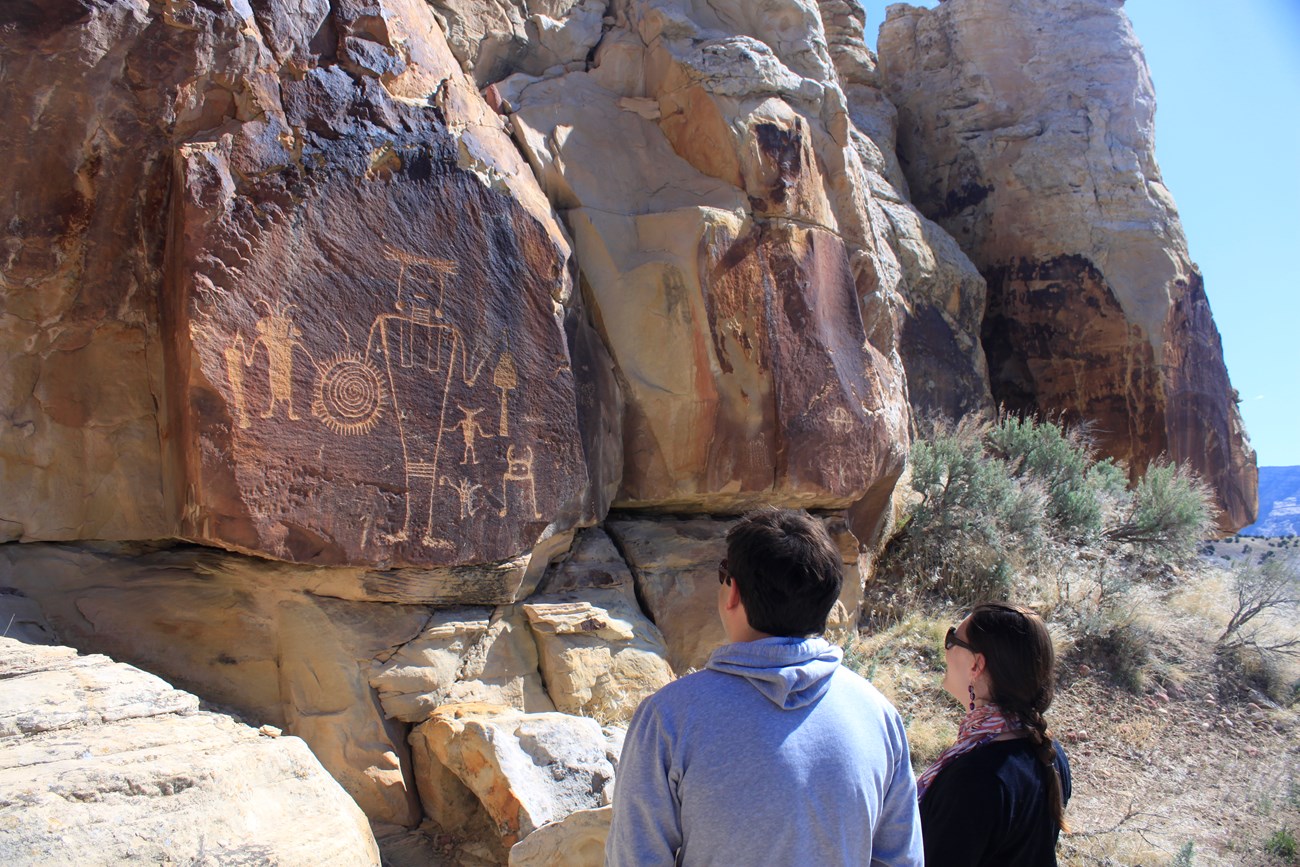
NPS / Dan Johnson Overview
Dinosaur National Monument is home to a vast and rich cultural history. Since time immemorial, people have lived and migrated through here, drawn by the natural riches of the area. Proximity to the Green and Yampa rivers provided a reliable water source, while the natural alcoves and canyons offered cool shade and respite from the desert sun. An abundance of archeological evidence, including stone tools, granaries, and homes reveal that people have lived in the area for at least 10,000 years. The presence of petroglyphs (etchings) and pictographs (paintings) on the rockfaces throughout the monument show us that life was comfortable and allowed people to devote a substantial amount of time to the creation of these images. Many of the petroglyphs and pictographs found within Dinosaur National Monument are attributed to the Fremont peoples, whose descendants still reside in this area today. In the 1700s, Spanish explorers arrived in the region. Descriptions of the area, like those provided in the journal from the Dominguez and Escalante Expedition, helped open the door for others from Europe and the eastern United States. Some of the first European visitors to this area were trappers and traders for the Rocky Mountain Fur Company. In May 1825, a small group of these trappers set out from Green River, Wyoming in search of beaver pelts. They became some of the first to float the Green River through what became Dinosaur National Monument (they got as far as the rapids at Disaster Falls). Settlers also came to the area throughout the 1800s. Those who had access to the rivers left their mark on the landscape with homesteads. Others dried up with drought and moved away. Today, the remains of many homesteads are found alongside petroglyphs and pictographs. Families of successful homesteaders continue to live in the area. One of the most notable characters to ever pass through what became Dinosaur National Monument was John Wesley Powell. Even before his historic whitewater run through the Grand Canyon, the famous one-armed Civil War veteran led a company of men down the Green and Colorado rivers in 1869. While the company was not the first to explore these river canyons, they were the first to float them in their entirety. Twice. Though the hard-sided wooden boats have largely been replaced with inflatable rafts and kayaks, boating in the monument remains one of the most popular activities in Dinosaur. Today, visitors can float through many areas that still bear names originally given by Powell and his crew, including Gates of Lodore, Winnie’s Grotto, Whirlpool Canyon, Disaster Falls, Rainbow Park, and Split Mountain. History was made again in 1909, when a paleontologist named Earl Douglass arrived on a mission from the Carnegie Museum of Natural History in Pittsburgh, Pennsylvania. His task was to find intact dinosaur bones and send them back to the museum for display. After searching for many weeks, his team found the first bones of what would soon become the Carnegie Quarry in Jensen, Utah. This small section of the Morrison rock formation would go on to yield over 350 tons of fossils and become one of the most significant paleontological finds of the 20th Century. On October 4, 1915, President Woodrow Wilson established the 80 acres around the Carnegie Quarry as Dinosaur National Monument to protect the enormous find. On July 14, 1938, the park was expanded another 200,000 acres by President Franklin D. Roosevelt. This was in effort to protect the Green and Yampa rivers, and the ecosystems that depend upon them. These rugged river corridors, as well as the ecosystems and vast cultural history they preserve, were threatened by the proposal of the Echo Park Dam in 1949. The years following World War II had ushered in a period of economic growth for states in the upper Colorado River basin. As a result, the Bureau of Reclamation released its plans for a series of large dams along the upper section of the Colorado and its tributaries. The dams would have provided hydroelectric power, water for irrigation and recreation, and helped secure the region’s share of the Colorado River from states downstream. However, one of the dam sites proposed was Echo Park, located squarely in the heart of Dinosaur National Monument, at the confluence of the Green and Yampa rivers. When the Park Service expressed concerns that the dam would flood the canyons, forever destroying their history and natural beauty, conservationists from across the country came to Dinosaur’s defense. Fearing that a dam in Echo Park would set a precedent for development in other National Parks, they fought to bring Echo Park to national attention through pictures, compelling essays, news features, and films. In 1956, the battle came to an end when legislation for the project was signed without a dam at Echo Park. Following the decision, conservationists capitalized on the public support they’d built to campaign for more wilderness protection. Today, many historians credit the Echo Park Dam controversy as a landmark event in US environmental history that foreshadowed other achievements, such as the Wilderness Act and the Wild and Scenic Rivers Act. Perhaps most importantly, the decision on Echo Park displayed to lawmakers that many Americans did not want development in their National Parks and Monuments. Discover More
|
Last updated: April 30, 2024



